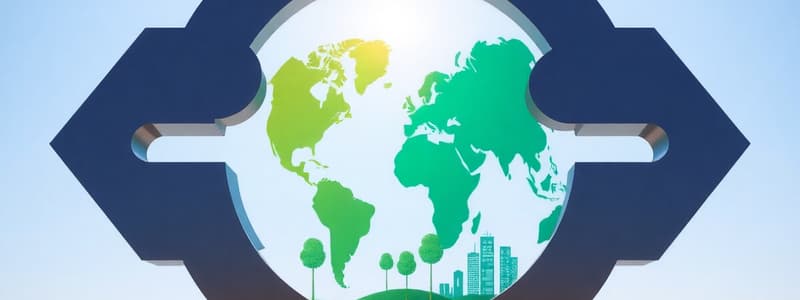Podcast
Questions and Answers
What characterizes a circular economy compared to a traditional linear economy?
What characterizes a circular economy compared to a traditional linear economy?
- Focus on minimizing waste and continuous use of resources. (correct)
- Encouragement of greater resource extraction from the environment.
- Increased reliance on one-time use of raw materials.
- Emphasis on a 'take-make-dispose' pattern of consumption.
Which of the following principles is NOT part of the circular economy framework?
Which of the following principles is NOT part of the circular economy framework?
- Minimize packaging and harmful byproducts.
- Encourage the use of virgin resources. (correct)
- Ensure products are durable, repairable, and recyclable.
- Design out waste and pollution.
What are the 'six Rs' associated with circular economy principles?
What are the 'six Rs' associated with circular economy principles?
- Remodel, Refashion, Reuse, Reclaim, Report, Reallocate.
- Rethink, Refuse, Reduce, Reuse, Repair, Recycle. (correct)
- Reinforce, Recover, Recycle, Redesign, Remediate, Rotate.
- Regulate, Replace, Reduce, Restore, Renewable, Rebate.
What is a significant challenge in integrating circular economy practices within international trade?
What is a significant challenge in integrating circular economy practices within international trade?
Which of the following best describes the concept of a zero balance in the context of circular economy?
Which of the following best describes the concept of a zero balance in the context of circular economy?
What is one of the main benefits of transitioning to a circular economy?
What is one of the main benefits of transitioning to a circular economy?
What was the effect of the 2008 financial crisis on top income shares?
What was the effect of the 2008 financial crisis on top income shares?
Which country experienced the most significant rise in inequality recently?
Which country experienced the most significant rise in inequality recently?
What does the concept of sustainability in a circular economy imply?
What does the concept of sustainability in a circular economy imply?
What is identified as a fundamental driver of income inequality?
What is identified as a fundamental driver of income inequality?
What trend was observed in global inequality from 2019 to 2020 due to the pandemic?
What trend was observed in global inequality from 2019 to 2020 due to the pandemic?
According to the findings on globalization, who are considered the 'losers'?
According to the findings on globalization, who are considered the 'losers'?
What is the estimated net gain of jobs globally by 2030 due to the transition to a circular economy?
What is the estimated net gain of jobs globally by 2030 due to the transition to a circular economy?
What potential reduction in artificial fertilizer use could a circular economy in European food systems achieve?
What potential reduction in artificial fertilizer use could a circular economy in European food systems achieve?
What is the expected percentage reduction in material costs in the automotive sector with a transition to a circular economy?
What is the expected percentage reduction in material costs in the automotive sector with a transition to a circular economy?
How much material cost savings could circularity in manufacturing potentially achieve?
How much material cost savings could circularity in manufacturing potentially achieve?
What is one of the main predictions regarding the construction sector's adaptation to circular economy practices?
What is one of the main predictions regarding the construction sector's adaptation to circular economy practices?
What trend has been observed in global exports of second-hand textiles between 1988 and 2018?
What trend has been observed in global exports of second-hand textiles between 1988 and 2018?
Which countries are identified as major exporters of second-hand textiles?
Which countries are identified as major exporters of second-hand textiles?
What was the average per unit value of a second-hand vehicle exported outside the EU in 2018?
What was the average per unit value of a second-hand vehicle exported outside the EU in 2018?
What has been the increase in value of second-hand car exports between 2000 and 2018?
What has been the increase in value of second-hand car exports between 2000 and 2018?
What is the implication of countries trying to achieve 'within growth' in the context of circular economy?
What is the implication of countries trying to achieve 'within growth' in the context of circular economy?
What is one reason the re-manufacturing industry remains low in the US and EU?
What is one reason the re-manufacturing industry remains low in the US and EU?
What potential issue arises from the trade of second-hand goods?
What potential issue arises from the trade of second-hand goods?
Which of the following represents a concern related to importing second-hand vehicles?
Which of the following represents a concern related to importing second-hand vehicles?
What was one of the actions taken by Russia in 2013 to protect domestic manufacturing?
What was one of the actions taken by Russia in 2013 to protect domestic manufacturing?
How has income inequality changed within countries since the 1980s?
How has income inequality changed within countries since the 1980s?
What trend has been observed in income distribution among the top earners in the US since 1980?
What trend has been observed in income distribution among the top earners in the US since 1980?
What effect has economic growth in emerging markets had on global inequality since 1980?
What effect has economic growth in emerging markets had on global inequality since 1980?
Which income group has typically experienced larger losses in income share recently?
Which income group has typically experienced larger losses in income share recently?
What type of trade barriers have been raised by the promotion of Circular Economy (CE)?
What type of trade barriers have been raised by the promotion of Circular Economy (CE)?
What impact has trade in hazardous waste created under certain conditions?
What impact has trade in hazardous waste created under certain conditions?
What is one of the significant environmental benefits of circular economy practices?
What is one of the significant environmental benefits of circular economy practices?
How does the circular economy create economic opportunities?
How does the circular economy create economic opportunities?
What advantage do businesses gain from adopting circular economy practices?
What advantage do businesses gain from adopting circular economy practices?
Which statement best represents the concept of promoting innovation in the context of a circular economy?
Which statement best represents the concept of promoting innovation in the context of a circular economy?
What is a key social benefit of implementing circular economy practices?
What is a key social benefit of implementing circular economy practices?
What is one way the circular economy can contribute to lowering final product prices?
What is one way the circular economy can contribute to lowering final product prices?
Which economic opportunity is associated with transitioning to a circular economy in Australia?
Which economic opportunity is associated with transitioning to a circular economy in Australia?
What is an impact of the circular economy on employment opportunities?
What is an impact of the circular economy on employment opportunities?
What results from reducing waste and resources consumption in the circular economy?
What results from reducing waste and resources consumption in the circular economy?
Flashcards
Circular Economy (CE)
Circular Economy (CE)
A sustainable economic model that uses resources continuously, minimizing waste, and regenerating natural systems.
Linear Economy (LE)
Linear Economy (LE)
Traditional economic model with a "take-make-dispose" pattern of production and consumption.
Resource Use in CE
Resource Use in CE
Circular economy emphasizes the reuse of resources, aiming for zero-waste systems and minimizing the reliance on virgin raw materials.
Six Rs of CE
Six Rs of CE
Signup and view all the flashcards
Design Out Waste and Pollution
Design Out Waste and Pollution
Signup and view all the flashcards
Zero-Waste System
Zero-Waste System
Signup and view all the flashcards
Rethinking Sustainable Development
Rethinking Sustainable Development
Signup and view all the flashcards
Circular Economy Job Impact
Circular Economy Job Impact
Signup and view all the flashcards
CE Impact on Agriculture
CE Impact on Agriculture
Signup and view all the flashcards
CE Impact on Automotive
CE Impact on Automotive
Signup and view all the flashcards
CE Impact on Manufacturing
CE Impact on Manufacturing
Signup and view all the flashcards
CE Impact on Construction
CE Impact on Construction
Signup and view all the flashcards
CE and International Trade
CE and International Trade
Signup and view all the flashcards
CE and Raw Material Trade
CE and Raw Material Trade
Signup and view all the flashcards
CE and Waste Management
CE and Waste Management
Signup and view all the flashcards
CE and Second-hand Textiles
CE and Second-hand Textiles
Signup and view all the flashcards
CE and Second-hand Cars
CE and Second-hand Cars
Signup and view all the flashcards
What is the benefit of CE for the Environment?
What is the benefit of CE for the Environment?
Signup and view all the flashcards
How does CE benefit the Economy?
How does CE benefit the Economy?
Signup and view all the flashcards
What are some benefits of CE for Businesses?
What are some benefits of CE for Businesses?
Signup and view all the flashcards
What are some benefits of CE for society?
What are some benefits of CE for society?
Signup and view all the flashcards
How does CE impact the Economy in Figures?
How does CE impact the Economy in Figures?
Signup and view all the flashcards
How does CE impact household income?
How does CE impact household income?
Signup and view all the flashcards
What is the potential economic benefit of CE in Australia?
What is the potential economic benefit of CE in Australia?
Signup and view all the flashcards
What are the main principles of CE?
What are the main principles of CE?
Signup and view all the flashcards
What are some key aspects of CE?
What are some key aspects of CE?
Signup and view all the flashcards
Income inequality
Income inequality
Signup and view all the flashcards
r>g
r>g
Signup and view all the flashcards
Skill premiums
Skill premiums
Signup and view all the flashcards
Global inequality
Global inequality
Signup and view all the flashcards
Pre-distribution
Pre-distribution
Signup and view all the flashcards
Remanufacturing Industry Share
Remanufacturing Industry Share
Signup and view all the flashcards
Trade-offs of Second-hand Goods
Trade-offs of Second-hand Goods
Signup and view all the flashcards
Trade Barriers and CE
Trade Barriers and CE
Signup and view all the flashcards
WTO Disputes over CE
WTO Disputes over CE
Signup and view all the flashcards
Within-country Inequality
Within-country Inequality
Signup and view all the flashcards
Across-country Inequality
Across-country Inequality
Signup and view all the flashcards
Income Share of the Top 1%
Income Share of the Top 1%
Signup and view all the flashcards
Income Loss for Low & Middle Classes
Income Loss for Low & Middle Classes
Signup and view all the flashcards
Global Wealth Distribution
Global Wealth Distribution
Signup and view all the flashcards
Capital in the 21st Century
Capital in the 21st Century
Signup and view all the flashcards
Study Notes
Key Skills for Corporate Transitions
- Circular economy, sustainability, trade, and income inequality are key skills for corporate transitions.
- Dr. Ioannis Bournakis, Associate Professor in Economics, presented this topic on October 2, 2024.
Circular Economy Definition
-
Environmentalists and economists increasingly argue about the interdependence between the environment and the economic system.
-
The transition to a circular economy system borrows the concept from thermodynamics in physics, where in a closed system the total energy is constant.
-
This implies a zero balance between consumed resources and released waste.
-
This model enables integrated closed-loops, ensuring continuous recycling, and avoiding virgin resources. Instead, it uses secondary raw materials.
-
It's a sustainable development model for urban management.
-
A circular economy (CE) is an economic model for sustainability, relying on continuous resource use, waste minimization, and regenerating natural systems.
-
This contrasts with a traditional linear economic model ("take-make-dispose") of production and consumption.
-
The key difference lies in resource use.
-
Linear economies use raw materials once, while circular economies emphasize reuse, stressing a more sustainable consumption model.
-
The six Rs (Rethink, Refuse, Reduce, Reuse, Repair, Recycle) are key principles.
Principles of Circular Economy (CE)
- Design Out Waste and Pollution:
- Products must be durable, repairable, and recyclable.
- Minimize packaging and harmful by-products.
- Reuse of products and materials:
- Recycle at end-of-life products.
- Maintain and repair products.
- Promote natural ecosystems:
- Use renewable energy sources.
- Promote innovation and resilience:
- Develop new technologies and business models.
- Enhance supply chain resilience.
Benefits of Circular Economy (CE)
- Environment:
- Promotes resource conservation and biodiversity.
- Contributes to lower CO2 emissions and a greener environment.
- Reduces waste and resource consumption, thereby improving environmental conditions.
- Economics:
- Creates new market niches, increasing employment opportunities in various sectors.
- Stimulates innovation in the recycling, manufacturing, and design sectors.
- Generate welfare gains for firms, leading to lower costs and prices for consumers.
- Businesses:
- Reduces raw material costs.
- Enhances brand reputation and customer loyalty.
- Strengthens customer and stakeholder relationships.
- Offers a competitive advantage to early adopters.
- Social:
- Encourages community engagement and collaboration.
- Stimulates innovation in recycling, manufacturing, and design.
Impact of CE in Figures
- Offers a 4.5 trillion USD economic opportunity by decreasing waste, boosting innovation, and providing employment in the circular economy.
- Shows potential European household income increases of €3,000 by 2030.
- Projects 210 billion USD in present value GDP in Australia by 2047-48 resulting from circular economy transitions.
- Forecasts 6 million new jobs globally by 2030 from circular economy transitions
Sector-Specific Impacts
- Agriculture - 80% reduction in artificial fertilizer use.
- Automotive – 20-30% reduction in material costs, highlighting better vehicle design, modularity, disassembly, and reuse of recycled resources.
- Manufacturing – 30-50% savings in material costs.
- Construction – 10-15% cost reduction through circular practices like recycling building materials and designing adaptable, modular structures.
CE and International Trade
- CE's increasing importance leads to a focus on "within growth" rather than international exchange.
- Cooperation among countries is possible within CE principles.
- Reduced trade in raw materials is anticipated, with an increase in secondary raw materials trade.
- Increased demand for waste management services and CE-compliant products is predicted
International Trade in CE: Some Evidence
- Worldwide second-hand textile exports increased 12% in weight and 26% in value between 1988 and 2018.
- OECD countries account for 77% of total second-hand textile exports in 2018.
- Second-hand car exports valued at 79%.
- Majority of these exports are within the EU (1265 thousand units in 2018).
- Average second-hand vehicle export values differ between intra-EU (higher) and extra-EU exports.
- The share of the re-manufacturing industry is low in both the USA (under 2%) and the EU (under 1.9%).
Food for thought
- Question: Why is this case?
- Answer: Regulatory barriers across different jurisdictions are relevant factors.
Trade-offs from International Trade in CE
- Trade in second-hand goods can fix economies on old, inefficient technologies.
- Imports of second-hand vehicles may cause environmental problems due to high emissions.
- Potential for illegal, hazardous, and contaminated waste trade.
- Possible issues with the right-to-repair and Intellectual Property Rights in trade agreements.
Trade Restrictions and CE
- Promotion of CE raises new trade barriers.
- 2013 WTO disputes regarding EU and Japan tariffs imposed by Russia, aiming to support domestic car manufacturers.
- China implemented a "Green fence" in 2013, raising concerns about raw material quality.
- Brazil and India restricting non-new products to encourage re-manufacturing.
Global Inequalities- Some Stylized Facts
- Income inequality within numerous countries has risen since the 1980s.
- Between-country inequality has fallen, due to growth in emerging economies like China and India.
- The income share of the top 1% and 0.1% rose significantly, especially in the US, as detailed in "Capital in the Twenty-First Century".
- Top 1% income share in the US has risen from about 10% in 1980 to over 20% in recent years.
Some Stylized Facts-Continued
- Low- and middle-income groups have lost income share.
- The gap between the top 10% and bottom 50% has almost doubled over the past two decades (from 8.5 to 15).
- US inequality rose more sharply than most European countries.
- France and Germany experienced more modest increases.
Causes on Income Inequality
- Increasing returns on capital (r) relative to economic growth (g) is a significant driver, according to "Capital in the Twenty-First Century."
- Technological progress and the resulting rise in skill premiums significantly widened the income gap globally, particularly in developed and developing countries.
- Globalization played a role in rising inequality.
- Decline in labor market institutions is another factor.
Globalization and the Evolution of Income Inequality
- Global inequality presents a new approach to the age of globalization.
- Winners: middle classes in emerging economies (especially Asia), global super-rich
- Losers: middle classes in developed countries.
- Globalization reduces between-country inequalities, while within-country inequalities may intensify.
- Improved income equality needs pre-distribution through more equal capital ownership, educational opportunities.
Studying That Suits You
Use AI to generate personalized quizzes and flashcards to suit your learning preferences.
Related Documents
Description
Explore the essential skills needed for corporate transitions, focusing on circular economy, sustainability, and trade. Dr. Ioannis Bournakis highlights the importance of these skills in addressing income inequality and promoting a sustainable future. Join this quiz to test your understanding of these key concepts.




